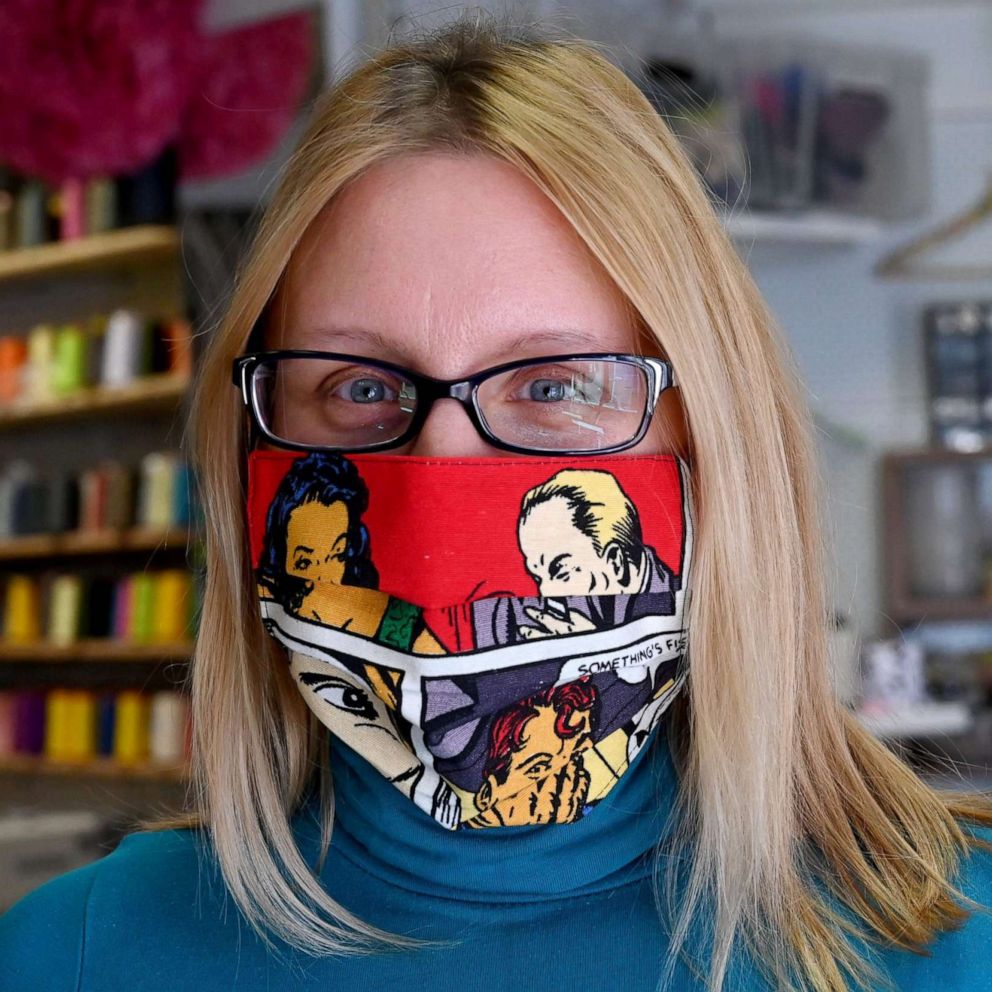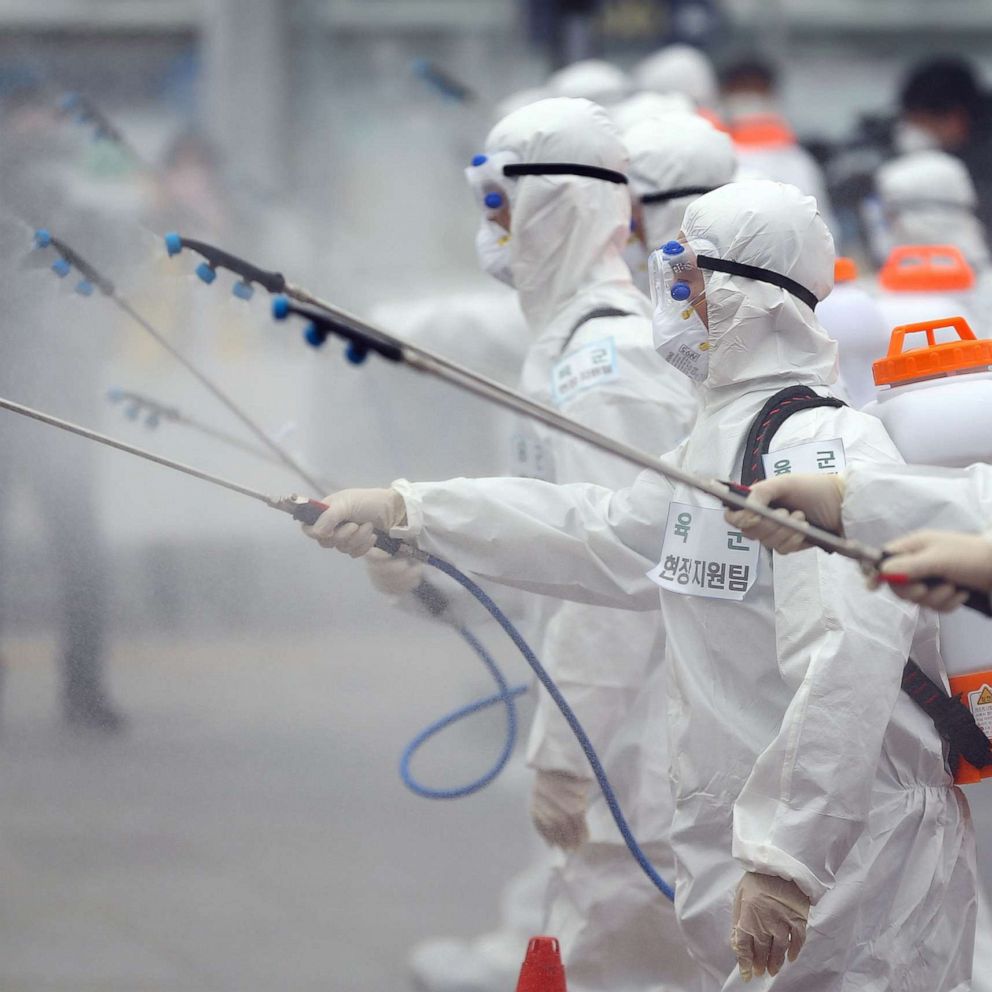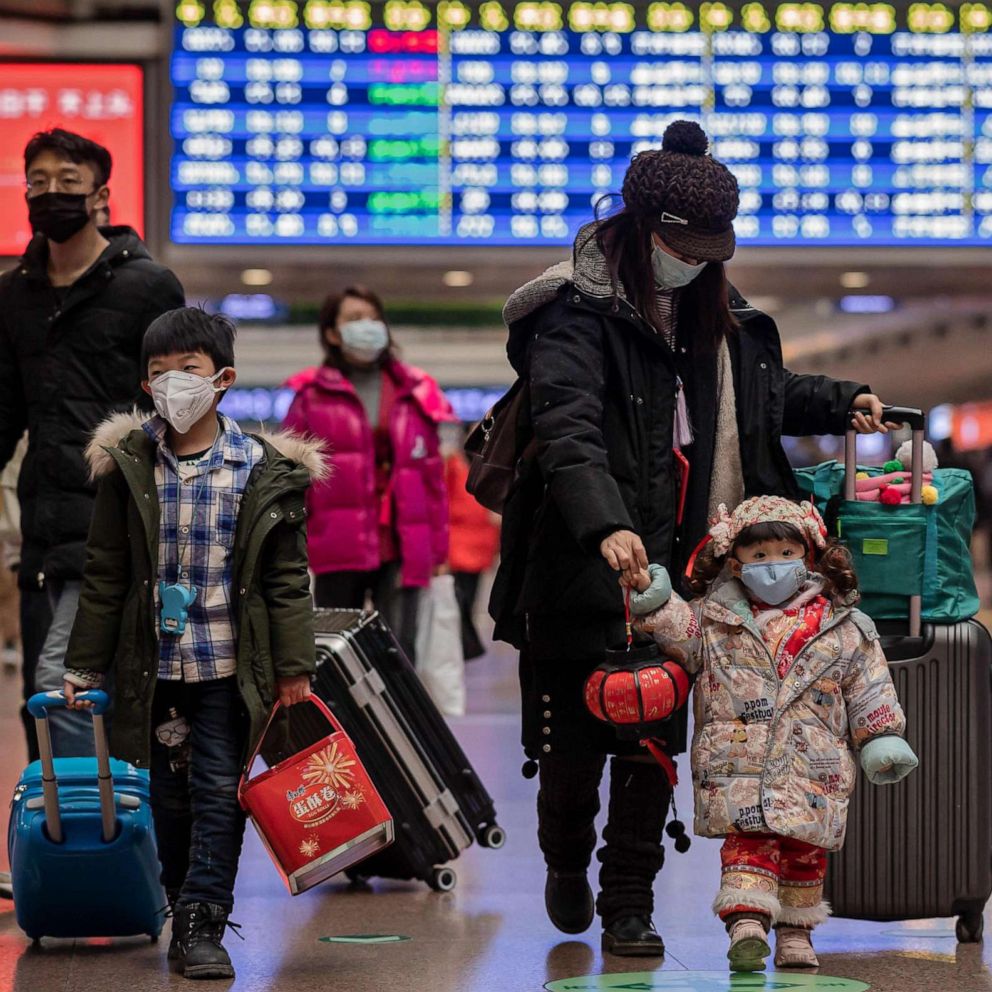Coronavirus government response updates: Trump says some states can start reopening 'literally tomorrow'
Trump has said 20 states are in “extremely good shape” to reopen soon.
As the U.S. economy continued to worsen dramatically with another staggering jobless claims report out Thursday, President Donald Trump said Thursday some states could start reopening "literally tomorrow."
Trump's plan to re-open the American economy after a near-total shutdown consists of three graduated phases.
In a call with governors, state leaders were instructed that they could move through the guidelines at their own pace and that the guidelines are not formal orders from the federal government, according to a person familiar with the call.
"Encouraging developments have put us in a very strong position to finalize guidelines for states on reopening the country," Trump said earlier Thursday, as the U.S. death toll from the coronavirus pandemic neared 30,000 Wednesday evening.
The president has said he would "authorize" governors' plans to reopen their states, after reversing his assertion of "total" authority in setting terms earlier this week -- a comment which drew rebukes from several governors, some of whom banded together by region to form geographically-coordinated responses to the virus.
Also speaking from the White House Rose Garden on a chilly Wednesday evening, Vice President Mike Pence, leading the coronavirus task force, signaled data from each state will be used to form the guidance, so states with fewer cases will be given more flexibility.
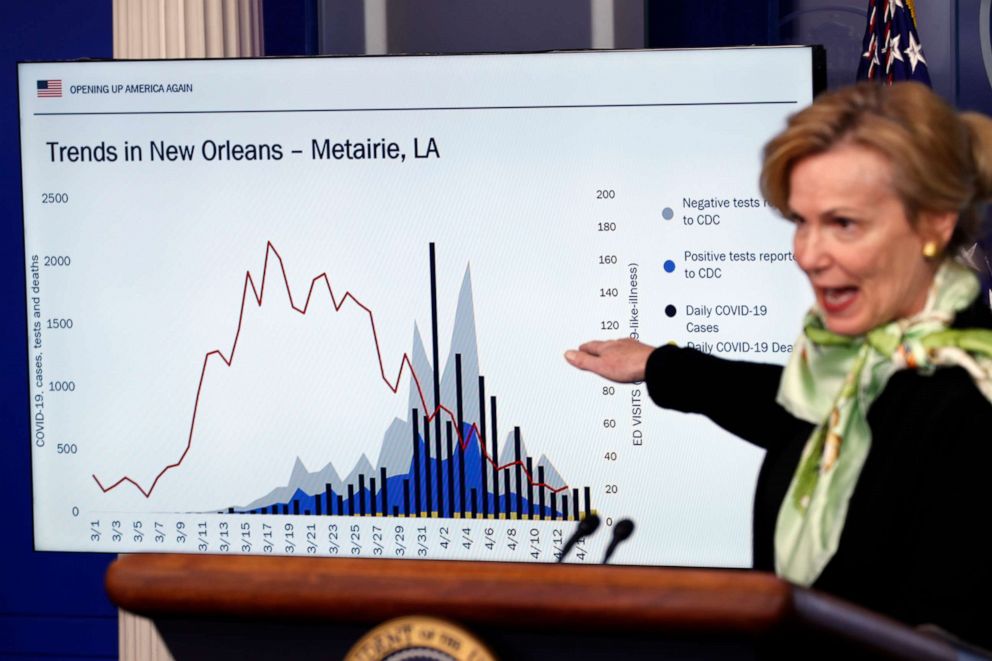
"Twenty-four percent of the counties of this country have no reported coronavirus cases. In fact, half of the states in America have less than 2,500 cases per state," Pence said. "We are going to reflect on the fact that there will be areas of the country that will require continued mitigation, strong efforts, and there will be other areas of the country that will be given guidance for greater flexibility."
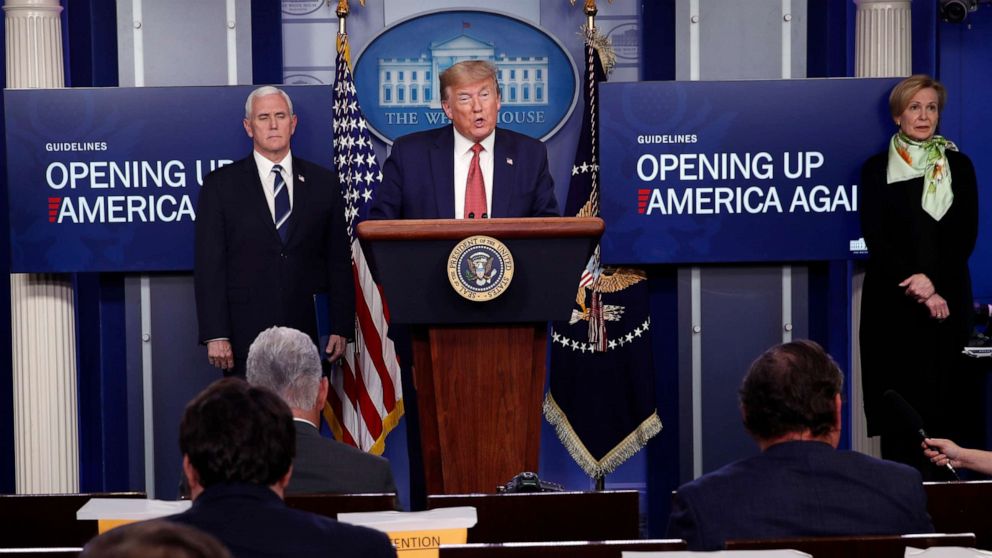
While Trump and his task force pointed to areas of the country with fewer cases, the government's top expert on infectious diseases Dr. Anthony Fauci, absent from the Wednesday briefing, told ABC News anchor David Muir on "World News Tonight" to expect a slow rollout dictated by local authorities -- one that's heavily dependent on that community's ability to test, provide medical care and do contact tracing.
Many who have the president's ear have acknowledged that widespread testing and contact tracing is necessary to open the country and get Americans back to work, but Trump has denied any problems with access to testing in the U.S. and continues to push for a May 1 reopening, if not before.
Tune into ABC at 1 p.m. ET and ABC News Live at 4 p.m. ET every weekday for special coverage of the novel coronavirus with the full ABC News team, including the latest news, context and analysis.
Here are Thursday's most significant developments in Washington:
- Trump, Pence teleconference with governors on 'economic revival,' announce new reopening guidelines for states
- Many Americans are encountering problems as relief checks hit bank accounts
- Trump says US has 'passed the peak for new cases' nationwide, while doctors have cautioned different areas will have varied peaks
- Trump threatens to unilaterally 'adjourn' Congress amid the pandemic if his judicial nominees are not approved
- Fauci says widespread testing and contact tracing necessary for reopening, Trump says testing is up to states

Trump says some states could reopen 'literally tomorrow'
When asked about states like Montana and Utah that already meet the “gating criteria” -- including a downward trajectory of coronavirus-like symptoms for 14 days, a downward trajectory of cases or positive tests for 14 days and robust testing for health care workers -- Trump said they could enter phase one of reopening “literally tomorrow.”
“They will be able to go in literally tomorrow because they have met all of the guidelines,” Trump said. “You're going back 14 days, you’re going back even a month and they have -- the ones that I'm thinking about, the ones I’ve already spoken to governors about -- they’ve met those guidelines actually pretty long ago."
Phase one allows for large venues, including churches and gyms, to open if they operate under “strict” social distancing and sanitation protocols. Elective surgeries can also resume.
Asked if he’s setting milestones for the country by certain dates, Trump said he doesn’t want to offer predictions "because you have a couple of states that are in difficulty." He added that some states will start opening before the end of the month.
“I think we are going to have a lot of states open relatively soon. We are beating the date. I set the date of May 1st, and here we are, and I think you're going to have some nice surprises over the next few days,” Trump said.

Fauci: Plan is 'exact opposite' of flipping on light switch
The nation’s top expert on infectious disease, referring to the reopening of the American economy, said the plan is not like flipping on a light switch but rather the “exact opposite,” which is a good thing.
Fauci said it will take a careful and "staggered" approach with an eye to the health and safety of the public.
“Not every state in every region is going to do it at the same time, that's clearly obvious because of the very dynamics of the outbreak," Fauci said.
He pointed out that some areas won't be able to reach phase one yet, because they have not met the gating criteria.
"You will see that there are some regions, states, locations that are going to be almost already into some of that gating and will have already fulfilled some of the criteria," Fauci said. "Others, because the dynamics of the outbreak in the area, will take longer to be able to do that but you don't get to phase 1 until you get through the gating."
Fauci said a “new normal” -- expected to mostly come about during phase three of the White House’s plan to reopen -- could include sporting events and concerts, although there’s no uniform answer for the country as a whole.
“The answer is, it is conceivable that we will be able to do that,” Fauci told ABC News Chief White House correspondent Jonathan Karl.
“I think we’ll be able to have sports events in that phase where you actually have participants there. I'm not sure you're going to be able to do that uniformly and evenly temperately with everyone,” Fauci said.
But he warned that a rebound of any kind would put states and cities back at square one.
“I mean, let's face it. This is uncharted water. There may be some setbacks that we may have to pull back a little and then go forward. But Jon, the direct answer to your question, I do see us getting more towards normal,” Fauci said.
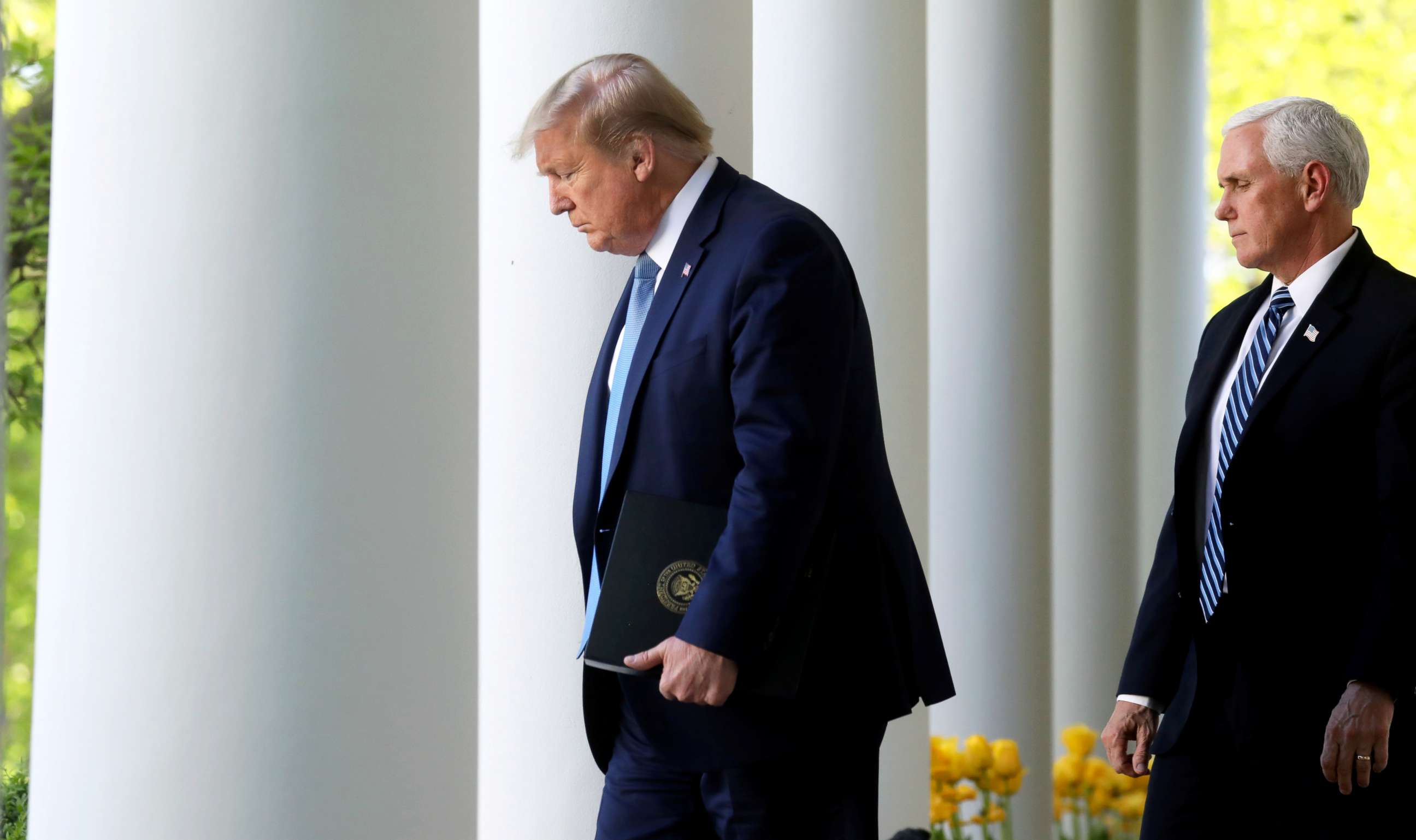
Birx details the new guidelines
The guidelines, obtained by ABC News Thursday afternoon, are broken up into three phases with each phase building from the last one. Governors can move through the guidelines at their own pace and were told that they are not orders from the government, according to a person familiar with the earlier call.
There is a two-week "gatekeeping criteria" that all states should achieve before they can move to phase one -- such as decreasing cases and testing for health care workers -- and each state must continue to meet the above criteria for two additional weeks to graduate to the proceeding phase.
Phase one says to telework where possible, return to work in phases and minimize non-essential travel. It calls on vulnerable individuals to "shelter in place," and for all to continue social distancing in public. Large venues, including churches and gyms, can open if they operate under “strict” social distancing and sanitation protocols. Elective surgeries can resume.
In phase two, non-essential travel can resume, and schools and organized youth activity can reopen. Bars can operate with diminished standing room occupancy. Large venues can continue under “moderate” social distancing protocols.
The third phase says all these venues -- bars, gyms and large venues -- can reopen with “limited” social distancing and “standard” sanitation. Employers can resume “unrestricted staffing of worksites,” so employees can physically return to work. This final phase also reintroduces visits to senior care facilities and hospitals.
Dr. Deborah Birx, White House coronavirus response coordinator, said another key component in reopening states is strong surveillance systems, especially in vulnerable communities such as nursing homes, inner-city groups and in indigenous populations, so health officials can use contract tracing to track and isolate infected who may not know they are carrying the virus.
“We want to be able to find them (infected individuals) in communities of particular vulnerability, so we will be doing sentinel surveillance throughout nursing homes, inner-city federal clinics, indigenous populations, to really be able to find early alerts of asymptomatic individuals in the community,” Birx said. “This is a very much big focus of the plan moving forward.”
Birx also said that phase three of the guidance is “essentially returning to our new normal.”
"Phase three -- I won't go through in detail -- but it's essentially returning to our new normal with all of what we talked about through all phases continuing the goodhygiene practices, continuing the respect for spaces between individuals because we know that we still have an issue with asymptomatic spread.”

Trump announces 'Opening Up America Again'
Trump officially announced federal guidelines “that will allow governors to take a phased and deliberate approach to reopening their individual states” to the public during the White House briefing on Thursday, calling it “Opening Up America Again." Trump initially unveiled the plan in a video conference call with the nation's governors earlier that afternoon.
“Based on the latest data, our team of experts believes we can begin the next front in our war, which we are calling ‘Opening up America again' -- and that's what we're doing,” the president said, repeating a message he has touted for weeks.
“America wants to be open and Americans want to be open. As I have said for some time now, a national shutdown is not a sustainable long-term solution. To preserve the health of our citizens, we must also preserve the health and functioning of our economy,” he said.
The president, comparing public health and the economy, said, “over the long haul, you can't do one without the other” and pointed to the dangers, he said, that would come from a prolonged lockdown.
“A prolonged lockdown combined with a forced economic depression would inflict an immense and wide-ranging toll on public health, this includes a sharp rise in drug abuse, alcohol abuse, suicide, heart disease, and many other dimensions of physical and mental well-being,” he said.
Trump explained that the guidelines would come in three phases and that “since every state is very different,” the decision on when to reopen economies would be up to governors. Gesturing to Birx, he said their strategy was based on “hard, verifiable data.”
“We are not opening all at once, but one careful step at a time. And some states will be able to open up sooner than others. Some states are not in the kind of trouble that others are in,” Trump said. “If they need to remain closed, we will allow them to do that, and if they believe it is time to reopen, we will provide them the freedom and guidance to accomplish that task and very quickly, depending on what they want to do.”
Trump also said he is encouraging states to work together to harmonize their regional efforts -- after governors in the Northeast, West Coast and Midwest previously announced they were forming regional coalitions to respond to the virus with geographically-coordinated plans.
Trump declares victory against coronavirus models
Trump began the daily White House briefing by declaring victory against the projected models. In recent weeks, predicted death tolls have ranged from 2 million to 100,000, but "with mitigation, it's looking like we will come far under even these lowest numbers," Trump said Thursday, referring to the lower estimates.
"Thanks to our all-out military operation and the extraordinary devotion of our people, we believe we will experience far fewer deaths than even the optimistic projection. But there is no such thing as an optimistic projection on death. One person is too many," Trump said.
The president also addressed concerns that there may be a resurgence in cases after the country opens.
“If the virus returns in the fall -- as some scientists think it may possibly -- these guidelines will ensure our country is up and running so that we can likewise put it out quickly,” Trump said.
The president cited medical research and clinical trials that could help improve outcomes and help patients.
Trump unveils his plan to reopen the economy to governors
In a video conference call with the nation's governors, the state leaders were instructed that they could move through the guidelines at their own pace and that the guidelines are not formal orders from the federal government, a person familiar with the call told ABC News.
The plan is divided into three graduated phases, according to a copy of the proposed actions obtained by ABC News that can be seen here.
-- ABC News' Katherine Faulders and Justin Fishel
Small business fund to prevent layoffs amid pandemic is officially out of money
The Paycheck Protection Program, a small business relief fund set up by Congress in response to the coronavirus pandemic, has exhausted its $350 billion in funding, as Party leaders remain in tense negotiations over how to replenish the fund.
As of 10:33 a.m., the Small Business Administration says it is "unable to accept new applications for the Paycheck Protection Program based on available appropriations funding."
The program was designed to prevent layoffs during the pandemic, as its loans can be forgiven if businesses maintain their payrolls.
The SBA has not specified how many businesses might have been waiting for their application to process or who will not be able to receive a loan.
-- ABC News' Sarah Kolinovsky and Trish Turner
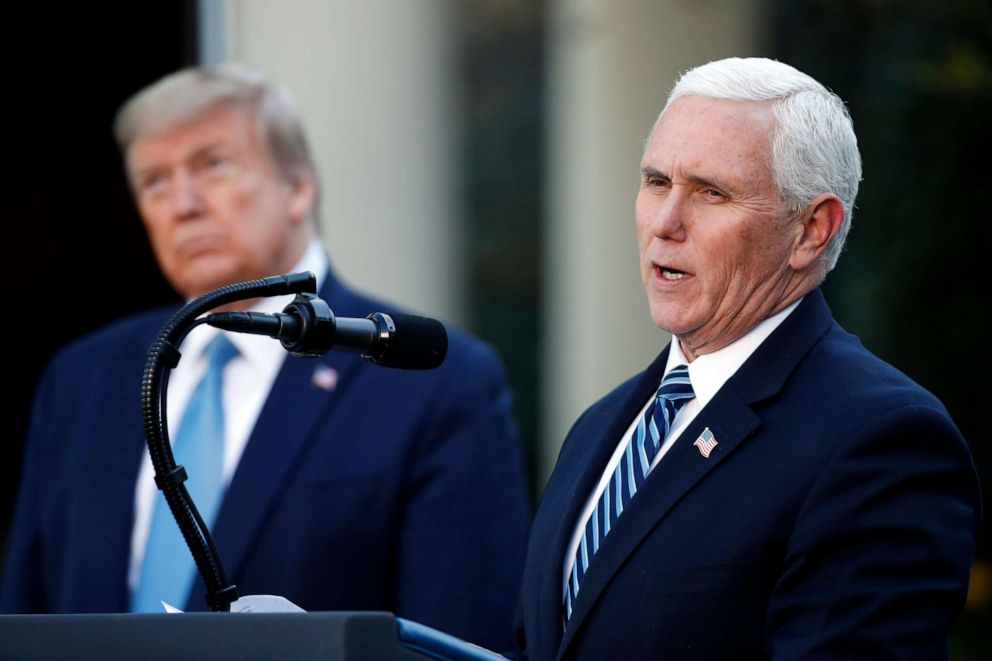
Many encounter roadblocks as stimulus checks hit bank accounts
More than 80 million Americans can expect to receive emergency coronavirus relief payments direct deposited into their bank accounts this week, according to the Treasury Department, but people are already reporting roadblocks.
As the payments roll out, many of those eligible to receive them are encountering problems ranging from persistent error messages on the new online payment tracking tool to money deposited into the wrong account.
There are also reports of payments going to people who are deceased.
The checks were a cornerstone feature of the $2 trillion emergency relief package passed by Congress in March. Individuals making $75,000 or less and couples making $150,000 or less are eligible to receive $1,200. Individuals and couples in those income brackets also are eligible for $500 for each child 17 or younger.
In a step experts call unprecedented, President Donald Trump's name will also appear on those paper checks expected to start being issued via mail "early next week," a Treasury Department spokeswoman told ABC News Wednesday, while denying adding his name would delay checks from going out.
-- ABC News Sarah Kolinovsky, Stephanie Wash and Beatrice Peterson
Dept. of Labor: 5.2 million more Americans filed for unemployment last week
As businesses were forced to close and Americans stay inside amid the novel coronavirus pandemic, a record-shattering 22 millions people have filed for unemployment in the last month, wiping out a decade of employment gains.
Last week alone, 5.2 million people filed for unemployment, according to a Department of Labor report released Thursday morning.
The unprecedented influx in jobless claims has created a number of issues for those in dire need of benefits as Americans across the country report ongoing struggles in applying for unemployment insurance.
What to know about Coronavirus:
- How it started and how to protect yourself: Coronavirus explained
- What to do if you have symptoms: Coronavirus symptoms
- Tracking the spread in the US and Worldwide: Coronavirus map
